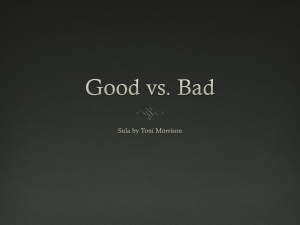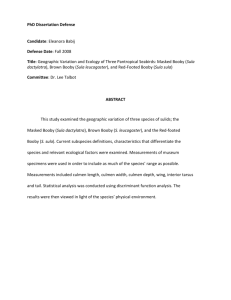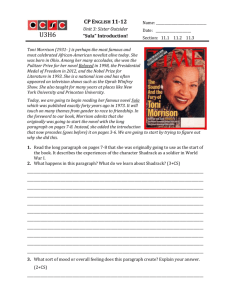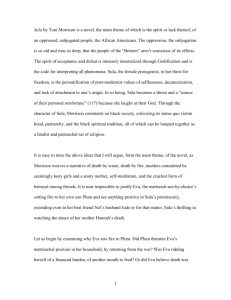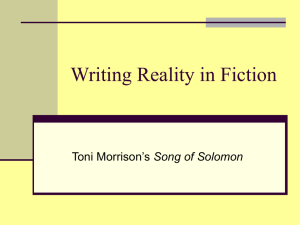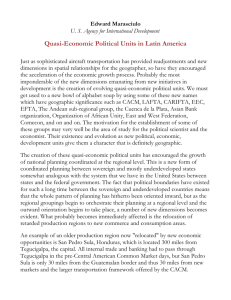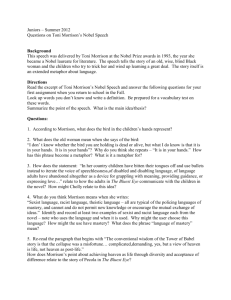Marginalization and Oppression of Afro
advertisement
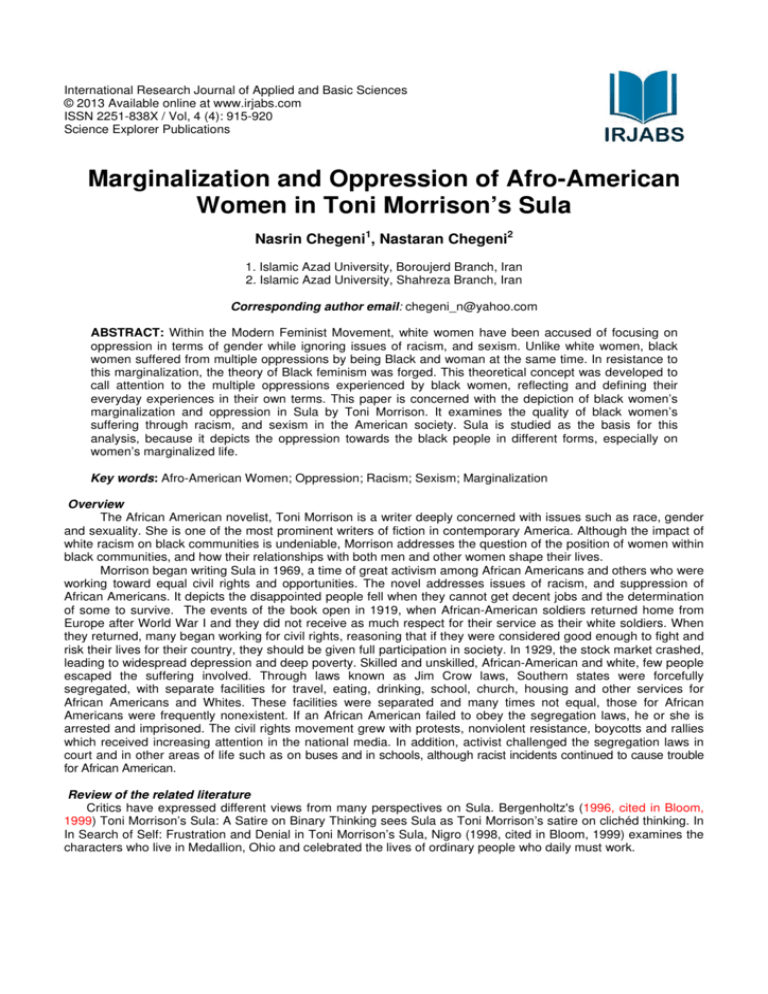
International Research Journal of Applied and Basic Sciences © 2013 Available online at www.irjabs.com ISSN 2251-838X / Vol, 4 (4): 915-920 Science Explorer Publications Marginalization and Oppression of Afro-American Women in Toni Morrison’s Sula Nasrin Chegeni1, Nastaran Chegeni2 1. Islamic Azad University, Boroujerd Branch, Iran 2. Islamic Azad University, Shahreza Branch, Iran Corresponding author email: chegeni_n@yahoo.com ABSTRACT: Within the Modern Feminist Movement, white women have been accused of focusing on oppression in terms of gender while ignoring issues of racism, and sexism. Unlike white women, black women suffered from multiple oppressions by being Black and woman at the same time. In resistance to this marginalization, the theory of Black feminism was forged. This theoretical concept was developed to call attention to the multiple oppressions experienced by black women, reflecting and defining their everyday experiences in their own terms. This paper is concerned with the depiction of black women’s marginalization and oppression in Sula by Toni Morrison. It examines the quality of black women’s suffering through racism, and sexism in the American society. Sula is studied as the basis for this analysis, because it depicts the oppression towards the black people in different forms, especially on women’s marginalized life. Key words: Afro-American Women; Oppression; Racism; Sexism; Marginalization Overview The African American novelist, Toni Morrison is a writer deeply concerned with issues such as race, gender and sexuality. She is one of the most prominent writers of fiction in contemporary America. Although the impact of white racism on black communities is undeniable, Morrison addresses the question of the position of women within black communities, and how their relationships with both men and other women shape their lives. Morrison began writing Sula in 1969, a time of great activism among African Americans and others who were working toward equal civil rights and opportunities. The novel addresses issues of racism, and suppression of African Americans. It depicts the disappointed people fell when they cannot get decent jobs and the determination of some to survive. The events of the book open in 1919, when African-American soldiers returned home from Europe after World War I and they did not receive as much respect for their service as their white soldiers. When they returned, many began working for civil rights, reasoning that if they were considered good enough to fight and risk their lives for their country, they should be given full participation in society. In 1929, the stock market crashed, leading to widespread depression and deep poverty. Skilled and unskilled, African-American and white, few people escaped the suffering involved. Through laws known as Jim Crow laws, Southern states were forcefully segregated, with separate facilities for travel, eating, drinking, school, church, housing and other services for African Americans and Whites. These facilities were separated and many times not equal, those for African Americans were frequently nonexistent. If an African American failed to obey the segregation laws, he or she is arrested and imprisoned. The civil rights movement grew with protests, nonviolent resistance, boycotts and rallies which received increasing attention in the national media. In addition, activist challenged the segregation laws in court and in other areas of life such as on buses and in schools, although racist incidents continued to cause trouble for African American. Review of the related literature Critics have expressed different views from many perspectives on Sula. Bergenholtz's (1996, cited in Bloom, 1999) Toni Morrison’s Sula: A Satire on Binary Thinking sees Sula as Toni Morrison’s satire on clichéd thinking. In In Search of Self: Frustration and Denial in Toni Morrison’s Sula, Nigro (1998, cited in Bloom, 1999) examines the characters who live in Medallion, Ohio and celebrated the lives of ordinary people who daily must work. Intl. Res. J. Appl. Basic. Sci. Vol., 4 (4), 915-920, 2013 Christian (1980, cited in Bloom, 1999) in The Contemporary Fables of Toni Morrison reads Sula as a paradoxical fable, at once a critique of the community’s failure to live, and yet a celebration of survival. Spillers (1983, cited in Bloom, 1999) in his article “A Hateful Passion, a Lost Love” traces the changes in black female characterization in transition from Zora Neale Huston and Margaret Walker to Toni Morrison. Dematakopoulos' (1987, cited in Bloom, 1999) Sula and the Primacy of Woman-to-Woman Bonds emphasizes the primacy of the relationship between Nel and Sula. Harris (1991, cited in Bloom, 1999) in his article “In Sula: within and Beyond the African American Folk Tradition” comments upon the ironies of Sula, which subvert morality and ideology. Carmean's (1993, cited in Bloom, 1999) in Toni Morrison’s World of Fiction suggests that Sula’s aim is to help us give up a simplistic dualism. Haunt (1993, cited in Bloom, 1999) in War and Peace: Transfigured Categories and the Politics of Sula returns us to a dualistic politics, even as she decries white political dualism. In Shocked into Separateness: Unresolved Oppositions in Sula, Page (1995. cited in Bloom, 1999) accurately shows that Sula incarnates a series of unsolved opportunities, while Basu (1996, cited in Bloom, 1999) in The Black Voice and the Language of the Text: Toni Morrison’s Sula praises Morrison for catching the Black voice (Bloom, 1999). Furman's (1996, cited in Bloom, 1999) in Black Girlhood and Black Womanhood: The Bluest Eyes and Sula sees Sula as unthinking and childlike and so destructive. Statement of the Problem The objective of this paper is to represent the various levels of women’s oppression in South Africa and America described in the novel and to explore the situation of female characters in the western racist society and how they resist against such a patriarchal society to achieve self-awareness and self-empowerment. Sula represents women of the 1960s, when she finds her power not within her community, but in her rebellion against it. Sula’s rebellion against her community is a fight which many African American women made in the 1960s when they chose not to conform to the traditional roles as daughters, mothers, and wives. Research Questions How can the issues of race, and sex discrimination contribute to Black women’s misery, suffering and oppression in Toni Morrison’s Sula? How do African- American women resist against the patriarchy and racism in a western racist society? Instrumentation This paper is concerned with the depiction of black women’s marginalization and oppression in Sula by Toni Morrison. It examines the quality of black women’s suffering through racism, and sexism in the American society. Sula is studied as the basis for this analysis, because it depicts the oppression towards the black people in different forms, especially on women’s marginalized life. Procedures The thesis uses the theoretical considerations of feminism and black feminism as a means to digest the covered layers of Morrison’s Sula. Black feminist thought is focused on the liberation of black women from the oppressors of race, class, gender, and sexual exploitation and in providing a community for Black women selfawareness and self- empowerment. By self-awareness, it means that Black women needed to actively recognize their multiple sources of oppression. By self-empowerment, it means that Black women should rely and depend on themselves. Toni Morrison can easily be read as a black feminist author. She was influenced by the ideologies of women’s liberation movements. Her novels discuss the experiences of the oppressed black minorities in isolated communities. The dominant white culture disables the development of healthy African-American women selfimage. Collins claims that black women can never become fully empowered in a context of social injustice. Morrison agrees with Collins’ statement, illustrating how the struggle in black women’s life culminates in the inequality between the blacks and the whites, as opposed to inequality between men and women that was the main concern of the white feminist movement of the 1960’s and 1970’s. Morrison pictures the harsh conditions of black women, without separating them from the oppressed situation of the whole minority. DISCUSSION Although some critics have provided different perspectives and articles about this novel on web sites, it is for the first time that the researcher has analyzed Sula based on a new interpretation. This theoretical concept was 916 Intl. Res. J. Appl. Basic. Sci. Vol., 4 (4), 915-920, 2013 developed to call attention to the multiple oppressions experienced by black women through racism, classism, gender and sexuality and the researcher has not found the critical analysis in this field in Iran universities. The Marginalization of Women in Toni Morrison’s Sula Women’s marginalization has been depicted mainly in Toni Morrison’s Sula from racism, and sexism. The reason I have chosen Sula is because it is written during the period of the Black Women’s Movement referring to the depiction of African-American women. It depicts the oppression towards the black people in different forms, especially on women’s marginalized life. Racism as a Topos in Sula Collins in Black Feminist Thought (1991) defines racism as a system of unequal power and privilege where people are divided into groups or races with social rewards unevenly distributed to groups based on their racial classification. Variations of racism include institutionalized racism, scientific racism and everyday racism. In the United States, racial segregation constitutes a fundamental principle of how racism is organized. The effects of racism upon black American life is a major topos in all of Morrison’s novels. Racism, in all its myriad forms, whether blatant or subliminal, is a part of every scene in Sula, with every aspect of the novel expressing some color of racism. The incidents in the novel are presented based on the life of the black community of the Bottom, which itself was established on a racist act. The Bottom was originally founded, because an African American slave was conned by a White slave owner into believing that the location of the town will be profitable. However, as with anything planted in the poor soil in the Bottom, the African American community struggles to survive. In the prologue, for example, the reader is informed that the hills on which the black neighborhood is situated were once considered worthless land. However, when the whites realized the potential of this land, it suddenly became valuable, they began buying the land, and the blacks were forced to move down into the valley. In Sula, except for the death of Chicken Little, all other instances can be linked to discriminatory political and socioeconomic policies. For instance, the draft policy in the case of the men who go to war, or the denial of jobs to the black people of Medallion, which angers them so much that they rush to their death unwittingly. This is certainly a more covert type of racism than what one character from the story experiences traveling south in a Jim Crow rail car, but the consequences are just as terrible. The continuous violence and the characters’ efforts to assume control over their own bodies hints to the historical circumstances of post-slavery racism and the condition of women at the beginning of the twentieth century. It is true that characters often learn from traumatic experiences, they develop strategies for survival or ways to intimidate, punish, or protest against those who have wronged them. But just as often, they fail, giving in to fear or indulging in self-deprecation. Such an example is Jude Greene. After attempting vainly to get a manly job building a new road in Medallion, Jude understands that neither him, nor the other black men from the Bottom will ever get hired. “[I]t was after he stood in lines for six days running and saw the gang boss pick out thin-armed white boys from the Virginia hills and the bull-necked Greeks and Italians and heard over and over, Nothing else today. Come back tomorrow, that he got the message” (Morrison's Sula, 1973). Determined “to a man’s role anyhow” (Morrison's Sula, 1973), he decides to get married so as to have “someone to take care about his hurt, to care very deeply. Deep enough to hold him, deep enough to rock him, deep enough to ask, How you feel? You all right? Want some coffee?” (Morrison's Sula, 1973). Surely enough, Jude’s married life is just what he imagined it will be, Nel, attentive to her husband’s needs, provides sympathy whenever Jude comes back home. Although the discrimination is real, Jude’s behavior takes away all remnants of dignity he had left. Even worse, Jude’s need for comfort only creates more misery, when the burden of family life becomes too heavy, he simply leaves. As a counterpart to these stories of failure, Sula portrays the ways in which characters reinvent themselves in order to survive. The 1919 chapter at the beginning of the book recounts Shadrack’s war experience and subsequent madness. The narrator states, “he had returned to Medallion handsome but ravaged, and even the most fastidious people in the town sometimes caught themselves dreaming of what he must have been like a few years back before he went off to war” (Morrison's Sula, 1973). The narrator adds: Twenty-two years old, weak, hot, frightened, not daring to acknowledge the fact that he did not even know who or what he was…with no past, no language, no tribe, no source, no address book, no comb, no pencil, no clock, no pocket handkerchief, no rug, no bed, no can opener, no faded postcard, no soap, no key, no tobacco pouch, no soiled underwear and nothing, nothing, nothing to do […] he was sure of one thing only: the unchecked monstrosity of his hands. (Morrison's Sula, 1973) 917 Intl. Res. J. Appl. Basic. Sci. Vol., 4 (4), 915-920, 2013 The focus is not really on recalling the ravages of the war. Rather, the chapter follows Shadrack as he slowly invents another way of being and a different way of looking at the world around him. Although people in the Medallion are shocked to see him so changed and find themselves regretting the young man he was before the war, Shadrack’s ability to rebuild an identity and place some order in his vision of the world is nonetheless impressive and it is described in the book as a rebirth. “[T]he first sleep of his new life [was] deeper than the hospital drugs; deeper than the pits of plums, steadier than the condor’s wing; more tranquil than the curve of eggs” (Morrison's Sula, 1973). There is no hint of defeat or weakness in this passage, despite the fact that Shadrack never regains his sanity. Other veterans in the novel, who return home sane, have to suffer the indignities of racial prejudice. During the 1920s, the black soldiers returning from the Great War found that, in spite of their sacrifice, they were still subject to racial persecution; their return home in 1919 was marked by the highest number of lynchings in the United States. The veterans that Helene Wright and her daughter see on the train, in the train car for “COLORED ONLY,” have “closed face” and “locked eyes”; even their hatred is internalized, a mere “movement under the skin” (Morrison's Sula, 1973). Plum, the beloved son of Eva Peace, returns from war a heroin addict, exasperating his mother with his weakness until she sets him on fire. Racial discrimination ranges from political oppression to economic disempowerment. Following the relative prosperity of the war, new building projects are planned for Medallion, but they exclude giving work to the black people of the Bottom. The geographic exclusion of the black community is mirrored by an economic exclusion. Morrison in the first pages of the novel describes the relationship between the white community of Medallion and the black people in the Bottom as one of economic inequality. The white men who come to the Bottom are in the business of “collecting rent or insurance payments” (Morrison's Sula, 1973), while the black spoon carvers have been out of work for eight years. The story of how the Bottom describes a new kind of racial oppression is not based on political, but economic disempowerment: [A] good white farmer promised freedom and a piece of bottom land to his slave if he would perform some very difficult chores. When the slave completed the work, he asked the farmer to keep his end of the bargain. Freedom was easy – the farmer had no objection to that. But he didn’t want to give up any land. (Morrison's Sula, 1973). Therefore, the farmer gives his former slave some land up in the hills, reassuring him that “It’s the bottom of heaven – best land there is” (Morrison's Sula, 1973). One example of the Bottom’s racism is Helene Wright’s concern over her daughter Nel’s physical features. Although Helene does not want Nel to be as fair skinned as she is, she still forces her daughter to pull her nose in order to make it narrower. “While you sittin’ there, honey, go head and pull your nose. It hurts, Mamma. Don’t you want a nice nose when you grow up?” (Morrison's Sula, 1973). And yet Helene herself is the victim of racism, for having grown up in New Orleans, she knows the dangers of breaking Jim Crow laws, the mandates that segregated white society from black. Returning by train to New Orleans for her grandmother’s funeral, Helene realizes immediately that she has accidentally stepped over the line that separates the two races when a white conductor catches her in a “WHITES ONLY CAR” (Morrison's Sula, 1973). The narrator states: As they opened the door marked COLORED ONLY, they saw a white conductor coming toward them […] The conductor let his eyes travel over the pale yellow woman and then stuck his little finger into his ear, jiggling it free of wax. What you think you doin’ gal? […] What was you diin’ back in there? What was you doin’ in that coach yonde? […] We made a mistake, sir. You see, there was n’t no sign .We just got in the wrong car, that’s all. Sir. We don’t low no mistakes on this train. Now git your butt on in there. (Morrison's Sula, 1973) Another example of the white society’s racist attitudes occurs later in the novel, when a white bargeman finds Chicken Little’s corpse washed ashore at the river’s edge. Annoyed at the inconvenience of having to tote the black child’s body to the sheriff, the bargeman reacts as though it is not a human that has been lost. He even believes that the blacks are so savage that they would kill their own children. The narrator states: A bargeman, poling away from the shore, found Chicken late that afternoon stuck in some rocks and weeds […] He shook his head in disgust at the kind of parents who would down their own children. When, he wondered, will those people ever be anything but animals, fit for nothing but substitutes for mules, only mules didn’t kill each other the way niggers did. He dumped Chicken Little into a burlap sack and tossed him next to some egg crates and boxes of wool cloth.( Morrison's Sula, 1973) 918 Intl. Res. J. Appl. Basic. Sci. Vol., 4 (4), 915-920, 2013 In a society that segregates its healthcare facilities, many of which did not allow blacks to step inside their doors, it is not surprising that even those individuals whose skin is white but who have ethnic backgrounds other than Anglo-Saxon are treated better than the Bottom’s black residents. One of the key points Morrison makes in Sula is that newcomers, white immigrants, are given preferential treatment for menial jobs, while blacks, with their long history of living in the valley, are mistreated, even by the white immigrants. Sexism in Sula Towards the end of the nineteenth century, there were two different kinds of women, both kinds referred to as the New Women, started to emerge, the self-sufficient working girl and the dependent, restless parasite woman. Gradually, women realized what their position in the society of the United States was like animal and began to fight for its improvement. The New Women appealed to society’s sense of their victimization when they did demand compensation in the shape of legal, economic, and social reforms, they asked for political power to combat the forces that victimized them. These were the fields where the changes were most visible, but there was much more to change. Kennedy (1980) points out that, with the liberation of women, the transformation of masculine sexuality, the destruction of the double standard and the encouragement of a new sense of subjectivism, the nineteenth century had set the scene for the revolution in morals of the twentieth. Yet, it would be a mistake to assume that black women were included in this movement. At the beginning of the twentieth century, black women were still considered practically worthless. Watkins (1981) emphasizes the fact that little has changed since the times of slavery: As far back as slavery, white people established a social hierarchy based on race and sex that ranked white men first, white women second, though sometimes equal to black men, who are ranked third, and black women last [...] Most Americans, and that includes black people, acknowledge and accept this hierarchy; they have internalized it either consciously or unconsciously. (Watkins, 1981) Black women were not only at the bottom of the social hierarchy but also negative stereotypes were attributed to them. “[T]hese negative myths and stereotypes have effectively transcended class and race boundaries and affected the way black women were perceived by members of their own race and the way they perceived themselves” (Watkins, 1981). Thus, in addition to the racism black women encountered during their contact with white people, they often had to endure the harsh treatment of their husbands. In addition, Watkins claims that “the predominant image [of black women was] that of the fallen woman, the whore, the slut, the prostitute” (Watkins, 1981). Being surrounded by people with this attitude, black women could only find support and sympathy among other black women who were in the same situation, which is the reason why friendship played a significant role in black women’s lives. The plight in the black female characters in Sula is even worse than that of men, for they enjoy even less freedom. Nel and Sula are only twelve, but they already understand the limitations of their status, “[b]ecause each had discovered years before that they were neither white nor male, and that all freedom and triumph was forbidden to them, they had set about creating something else to be” (Morrison's Sula, 1973). For Sula, the only alternative is to reject the role of motherhood, for only in this way she can enjoy the same freedom as the men. She confesses without hesitation to her friend Nel that even if she had children she would abandon them to preserve her freedom, “[I] really would act like what you call a man. Every man I ever knew left his children” (Morrison's Sula, 1973). Unlike Nel, who describes independence as acting like a man, Sula feels that freedom and caring for one’s children are not roles that belong naturally to either men or women. For Nel, who feels she needs to provide for her children, freedom comes much later, when they no longer need her. In1965, Nel can afford to look around her, because there is nothing else to do. Remembering the past, she sorts she is able to separate the irrelevant things in her life and the truly important that is only the loss of her friend, Sula. CONCLUSION As it has already been mentioned, Toni Morrison can easily be read as a black feminist author. She speaks as a Black woman in a world that still undervalues the voice of the Black woman. Her novels especially lend themselves to feminist readings because of the ways in which they challenge the cultural norms of gender, race, and class. Black feminists propose that the Black woman and the Black woman writer negotiate multiple social locations in securing a place in American culture and literature—not only those of gender and class found in all feminist approaches but also that of race. As a result, Black women writers have always, out of necessity, had to maneuver outside of the dominant white (including the white woman’s) literary system. Their exclusion from the 919 Intl. Res. J. Appl. Basic. Sci. Vol., 4 (4), 915-920, 2013 mainstream literary traditions led them to develop and employ alternative means of communicating, drawing upon their own experiences of oppression and resistance to shape their texts and to represent the characters and situations within it. Morrison’s concerns for the Black society and the perseverance of its unique culture can be seen throughout her literary work. She always returns to the themes of marginalization and alienation of blacks in the white society. Therefore, this thesis attempts to represent the various levels of women’s oppression in South Africa and America described in Sula, and to explore the situation of female characters in the western racist society and how they resist against such a patriarchal society to achieve self-awareness and self-empowerment. Sula is the chronicle of the life of two black women from their growing up in a small Ohio town to their final clash. Sula, is depicted as a rebel. She rejects the social norms of the community, to live in a small town, to marry and to become a mother; whereas Nel, her childhood friend, has accepted them. After an exile, Sula and Nel embody the fight and survival of black American women. Such resistance manifests itself in Morrison’s emphasis on the discovery and rediscovery of Black life, especially that of the Black woman. REFERENCES Bloom H. 1999. Toni Morrison’s Sula, Modern Critical Interpretations. Philadelphia: Chelea House. Carmean K. 1993. Toni Morrison’s World of Fiction. Troy: Whitston. Christian B. 1981. Community and Nature: The Novels of Toni Morrison. Black Feminist Criticism. New York: Teachers College Press. Christian B. 1985. Black Feminist Criticism. New York: Pergamon Press. Collins PH. 1991. Black Feminist Thought: Knowledge, Consciousness and Politics of Empowerment. New York: Routledge. Morrison T. 1982. Sula. New York: Penguin Books. Morrison T. 1992. Playing in the Dark: Whiteness and the Literary Imagination. New York: Vintage. Nigro M. 1998. In Search of Self: Frustration and Denial in Toni Morrison’s Sula. Journal of Black Studies. Watkins GJ. 1981. Ain’t I A Woman: black women and feminism. Boston: South End Press Watkins GJ. 1992. Black Looks: Race and Representation. Boston: South End. Watkins GJ. 1995. Black Women Shaping Feminist Theory.” Boston: South End . . 920
